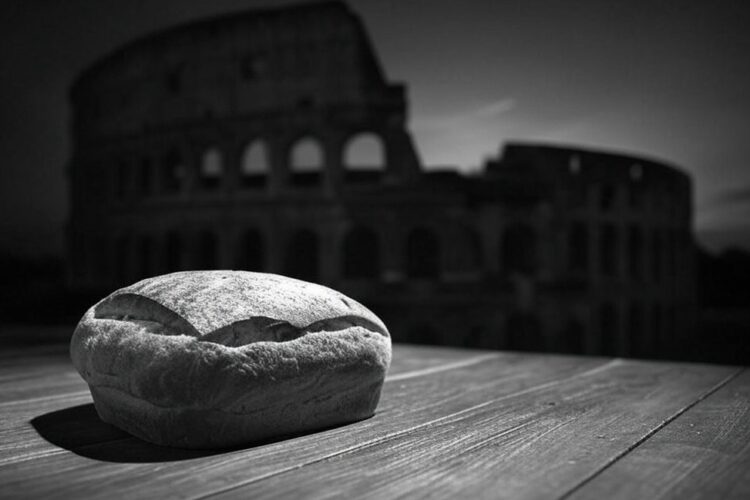“Bread and circuses,” coined by Roman poet Juvenal around 100 CE, describes a timeless strategy of control: keep the masses fed and entertained to distract from deeper issues. In ancient Rome, the grain dole ensured survival, while gladiatorial games and chariot races captivated millions, fostering apathy and consolidating power. This tactic persists through history—medieval feasts, Soviet propaganda, modern consumerism, and media spectacles like viral videos or sports events. Today, welfare programs and endless digital content mirror Rome’s playbook, pacifying society while masking political failures. Yet, when “bread” falters, unrest brews, and social media now challenges centralized narratives. Recognizing this dynamic empowers us to question distractions and reclaim agency in a world designed to keep us passive.
Long Version
The phrase “bread and circuses” echoes through history, a biting critique of political strategy and human nature that remains as relevant today as it was in ancient Rome. Coined by the Roman poet Juvenal in his Satires around 100 CE, the Latin panem et circenses encapsulates a simple yet profound idea: rulers can pacify the masses with basic sustenance and dazzling entertainment, diverting attention from deeper societal issues. From the grain dole of the Roman Empire to the media circus of the modern age, this concept has evolved into a lens through which we can examine power, control, and public apathy across centuries. This article delves into the origins, mechanisms, and enduring legacy of bread and circuses, exploring its historical roots, political strategies, and contemporary parallels with meticulous detail and insight.
The Origins: Juvenal and the Roman Context
Juvenal’s famous line, “The people that once bestowed commands, consulships, legions, and all else, now meddles no more and longs eagerly for just two things—bread and circuses,” was a lament for a Rome he saw as decaying. The Roman Empire, at its height, was a sprawling superpower, but its plebeians—the common people—were increasingly detached from civic life. The government, aware of this shift, leaned on two tools to maintain order: the grain dole and public spectacles.
The grain dole was Rome’s welfare system, a form of subsistence that provided free or subsidized grain to hundreds of thousands of citizens. Initiated during the late Republic and expanded under the emperors, it was both a pragmatic measure to prevent bread riots and a political strategy to secure loyalty. Meanwhile, the circuses—chariot races in the Circus Maximus, gladiator battles in the Colosseum—offered visceral entertainment. These spectacles, often funded by emperors or wealthy patrons, were more than mere diversions; they were propaganda, showcasing the state’s power and generosity.
This dual approach targeted the masses’ immediate needs and desires. Bread ensured survival; circuses provided escape. Together, they fostered a culture of dependency and distraction, a phenomenon Juvenal saw as the opium of the people, long before Karl Marx would echo a similar sentiment about religion. The plebeians, once active participants in Rome’s republican governance, became passive clients in a system of clientelism, where loyalty was traded for handouts and thrills.
The Mechanics of Distraction
At its core, bread and circuses is about social engineering—an orchestrated effort to manipulate the public’s focus. In Rome, the Colosseum could seat 50,000 spectators, while the Circus Maximus held up to 250,000, numbers that dwarf modern stadiums. Events like gladiatorial combat or chariot races were free, lavish, and frequent, ensuring the masses had little time or incentive to question the Senate or the emperor. The spectacle wasn’t just entertainment; it was a display of imperial might, with exotic animals, staged naval battles, and executions reinforcing the state’s dominance.
The grain dole complemented this by addressing physical survival. By the 1st century CE, nearly 200,000 Romans received monthly rations, a logistical feat that kept breadlines at bay and discontent in check. This wasn’t charity—it was control. Hungry citizens might revolt; fed ones were less likely to. Bread riots, a recurring threat in Rome’s history, dwindled as the dole became institutionalized, turning a potential weakness into a tool of appeasement.
This synergy of subsistence and spectacle created a feedback loop of public apathy. The masses, sated and entertained, ceased to demand accountability. Power consolidated upward, as emperors and elites used populism—policies favoring the common people—to mask their grip on authority. Bread and circuses thus became a blueprint for mass manipulation, a strategy that traded short-term satisfaction for long-term stability.
Bread and Circuses in History
The Roman model wasn’t unique; it was simply the most iconic. Throughout history, rulers have adapted this playbook. In medieval Europe, monarchs hosted tournaments and feasts to distract from feudal inequalities. During the French Revolution, bread shortages sparked riots, proving that the absence of “bread” could unravel even the most entrenched regimes. Napoleon later mastered the “circus” aspect, using military parades and grandiose projects to bolster his image.
The 20th century saw bread and circuses take industrial forms. In the Soviet Union, state-controlled breadlines and propaganda films kept citizens in line. Nazi Germany paired welfare programs with rallies and radio broadcasts, a chilling blend of sustenance and spectacle. Even democracies weren’t immune—America’s New Deal, while a genuine economic recovery effort, also included public works and radio fireside chats that soothed a restless populace during the Great Depression.
Each iteration refined the art of distraction. The tools changed—grain became wages, circuses became cinema—but the goal remained: to pacify the masses while preserving power. Bread and circuses thrived because it exploited a universal truth: people crave security and diversion, often more than they crave agency.
Modern Parallels: Consumerism and the Media Circus
Today, bread and circuses has metastasized into subtler, more pervasive forms. Consumerism is the new grain dole, with cheap goods and credit ensuring subsistence in a global economy. The average person may not queue for bread, but they line up for Black Friday sales or scroll endlessly through online marketplaces. This material appeasement keeps economic discontent at bay, much like Rome’s handouts quelled unrest.
The circuses, meanwhile, have gone digital. The modern media circus—24-hour news cycles, reality TV, social media feeds—delivers spectacle on demand. A viral video or a political scandal can captivate millions, drowning out substantive debate. Governments and corporations alike wield this power, using entertainment as propaganda. A blockbuster film or a celebrity meltdown can overshadow policy failures, just as gladiators once eclipsed Rome’s corruption.
Take sports as a case study: the Super Bowl or the World Cup draw billions of viewers, their pageantry rivaling the Colosseum’s bloodiest days. Politicians often align with these events, basking in reflected glory while deflecting scrutiny. Similarly, welfare states provide “bread”—social programs, tax credits—while algorithms curate “circuses” tailored to individual tastes. The result? A society where apathy reigns, not because people are powerless, but because they’re too distracted to care.
The Political Strategy Endures
Bread and circuses remains a cornerstone of political strategy because it works. Populism thrives on it, promising tangible benefits (jobs, healthcare) alongside emotional highs (rallies, slogans). Leaders from across the ideological spectrum—dictators, democrats, demagogues—have wielded it. It’s not about ideology; it’s about control.
Yet, it’s not foolproof. When the bread runs out—think economic crashes or supply chain failures—the circus alone can’t suffice. History shows that hungry, unentertained masses turn volatile, from Rome’s bread riots to modern protests over austerity. The strategy demands balance: too little bread, and unrest brews; too few circuses, and boredom festers into rebellion.
Moreover, the public isn’t always passive. The rise of social media has fractured the monopoly on spectacle—anyone can create a circus now. Governments must compete with influencers, memes, and grassroots movements, diluting their ability to dictate the narrative. Bread and circuses persists, but its execution grows trickier in an age of information overload.
Insights and Implications
What does bread and circuses reveal about us? It exposes a tension between human needs and human potential. We seek comfort and joy—bread and circuses deliver both—but at the cost of engagement. Juvenal’s critique wasn’t just about Rome; it was about the ease with which we surrender agency for ease. The Roman plebeians traded consulships for grain; today, we trade scrutiny for streaming.
The concept also challenges power structures. If distraction is a tool of control, awareness is its antidote. Recognizing bread and circuses—in policy, in media, in our own habits—empowers us to question what’s being obscured. Are tax breaks the new grain dole? Is a trending hashtag the new Colosseum? These questions cut through the noise, offering clarity in a distracted world.
Finally, bread and circuses underscores the durability of simple ideas. Juvenal’s phrase, penned two millennia ago, still resonates because it captures a fundamental dynamic of society. It’s not a relic; it’s a mirror, reflecting how power adapts to human nature across time.
Conclusion
From the Roman Empire to the digital age, bread and circuses has shaped the interplay of politics, society, and the masses. It began with grain and gladiators, evolved through feasts and films, and now thrives in consumerism and the media circus. At every stage, it’s been a tool of appeasement, a spectacle of distraction, and a testament to the ingenuity of control. Yet, it’s also a warning: when we accept bread and circuses uncritically, we risk becoming plebeians in our own story—fed, entertained, and quietly governed. Understanding its history and mechanics isn’t just an academic exercise; it’s a step toward reclaiming the agency Juvenal mourned, ensuring we demand more than just sustenance and show.
Hashtags For Social Media
#BreadAndCircuses #RomanHistory #AncientRome #PoliticalStrategy #SocialControl #HistoryLessons #ModernPolitics #MassDistraction #RomanEmpire #GladiatorGames #PublicEntertainment #HistoryVibes #PoliticalTactics #CrowdControl #HistoricalInsights #MediaManipulation #DystopianVibes #PopCultureHistory #RomanSociety #PropagandaTactics #HistoryFacts #EngageTheMasses #ViralHistory #SocialCommentary #LearnHistory #HistoryMemes #PoliticalHistory #AncientTactics #HistoryLovers #TrendyHistory
Related Questions, Words, Phrases
what is bread and circuses | meaning of bread and circuses | bread and circuses definition | history of bread and circuses | origin of bread and circuses | bread and circuses in ancient rome | what does bread and circuses mean today | bread and circuses political strategy | how was bread and circuses used in rome | bread and circuses in modern politics | examples of bread and circuses in history | bread and circuses and roman empire | why was bread and circuses important | bread and circuses social control | bread and circuses in literature | bread and circuses metaphor | how did bread and circuses work | bread and circuses and gladiators | bread and circuses in pop culture | bread and circuses distraction tactic | who coined bread and circuses | bread and circuses in dystopian fiction | bread and circuses and public entertainment | how bread and circuses shaped roman society | bread and circuses and mass manipulation | bread and circuses in modern media | what role did bread and circuses play in rome | bread and circuses and propaganda | bread and circuses in authoritarian regimes | how does bread and circuses apply to today | bread and circuses and social welfare | bread and circuses historical impact | bread and circuses and crowd control | bread and circuses in roman politics | bread and circuses and economic policy








